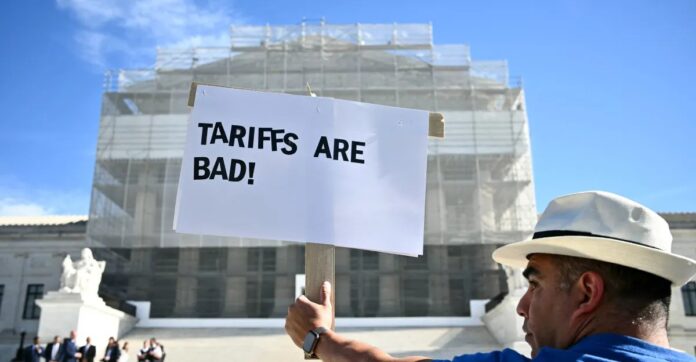The Supreme Court may soon deal a blow to President Donald Trump’s trade war, potentially offering American households a significant financial boost. However, the president could find ways to reinstate tariffs, albeit less efficiently.
A majority of justices appeared sympathetic during recent oral arguments to states and businesses challenging the legality of most of Trump’s tariffs. At issue is whether Trump can invoke the International Emergency Economic Powers Act (IEEPA) – a law meant for swift action in emergencies – to justify broad tariffs simply because of America’s trade deficit. Most economists and legal scholars dispute this rationale. They argue that the IEEPA doesn’t explicitly authorize such expansive tariff powers, raising constitutional questions about Congress delegating such authority to the president.
The Price Tag of Trump’s Trade War:
Trump has dramatically increased import taxes since taking office, pushing the average US tariff rate from 2.5% in January 2017 to 17.9% – its highest level since the Great Depression. These tariffs have had a tangible negative impact:
- Higher Prices for Consumers: Tariffs directly raise prices on imported goods, driving up the cost of everyday items and reducing purchasing power.
- Slower Economic Growth: By making imports more expensive, Trump’s tariffs increase production costs for American businesses, dampening investment and economic expansion.
A recent analysis by Yale’s Budget Lab estimates these tariffs could reduce US GDP growth by 0.5 percentage points in 2025 and 2026, ultimately shrinking the economy by a cumulative $105 billion annually. They also project that tariffs will increase prices by 1.3% in the short term, effectively costing the average household $1,800 per year.
- Increased Unemployment: Reduced investment and consumption fueled by higher prices contribute to job losses. The Budget Lab predicts a rise in unemployment by 0.7 percentage points by late 2026.
The Potential Relief:
If the Supreme Court strikes down Trump’s tariffs based on IEEPA, most of these economic harms would be reversed:
- Lower Prices and Increased Purchasing Power: Households would see prices fall for a wide range of goods, resulting in an average income gain of over $1,000 per year.
- Faster Economic Growth: Removing the drag on businesses would stimulate investment and production, leading to stronger economic expansion.
- Reduced Unemployment: Businesses experiencing relief from higher input costs would be more likely to hire.
The Catch: Trump’s Potential Workarounds:
While a Supreme Court ruling against Trump’s use of IEEPA would significantly reduce tariffs, it wouldn’t eliminate them entirely. He could employ other legal avenues to reimpose duties:
- Unfair Trade Practices: The Trade Act of 1974 allows tariffs on nations deemed to engage in unfair trade practices. This law has already been used against China.
- Trade Deficit: The same law permits the president to impose up to 15% tariffs for 150 days in response to a large trade deficit.
These avenues are less streamlined than IEEPA but still provide Trump with potential tools to resurrect his trade war, albeit in a more bureaucratic and potentially vulnerable manner.
Trump’s Political Calculus:
The White House may find itself pressured to scale back its trade war amid growing public discontent over inflation and the cost of living. Democrats have made gains in recent elections after capitalizing on voter anxiety about these issues. A Supreme Court ruling against Trump could offer a convenient cover for trimming tariffs without admitting a policy error. He could frame it as necessary due to judicial interference, allowing him to claim his hands were tied while making subtle concessions.
Whether this calculated political maneuver proves effective remains to be seen. But one thing is clear: the Supreme Court’s decision on Trump’s tariffs holds immense economic weight and will likely shape the trajectory of American households’ wallets and the broader economy for years to come.


















































